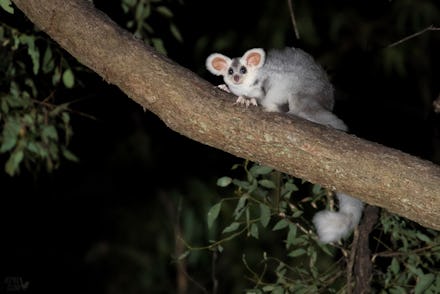This new species of flying marsupials are so cute I want to punch a wall

There's a species of flying marsupial in Australia called the 'greater glider' that can go from tree to tree like a cat-sized flying squirrel with a long, lemur-like tail. They're mostly active at night, rustling amongst the branches for leaves to eat or to make their homes. The gliders are immensely fuzzy from the tips of their round ears to the ends of their floofy tails. And now, thanks to a recent study published in Scientific Reports on November 6, we know there are more than one species of greater gliders.
This discovery might not come as a total surprise to glider experts. The marsupials' habitat range stretches along the entire east coast of Australia. And observers have noted some physical differences between various gliders in the past. Still, there wasn't any firm, genetic evidence of different species until now.
"There has been speculation for a while that there was more than one species of greater glider, but now we have proof from the DNA," study author Denis McGregor said in a James Cook University press release. "It changes the whole way we think about them."
For the longest time, all of the gliders were called Petauroides volans. Now, taxonomists can add two more species: P. armillatus and P. minor. Each one of them make up the majority of different glider communities located in the south, central, and north regions of Australia's east coast respectively.
"For the first time, we were able to use [genetic] sequencing to provide genetic support for multiple species," added co-author Andrew Krockenberger. "Australia's biodiversity just got a lot richer. It's not every day that new mammals are confirmed, let alone two new mammals."
Even though they're all the same level of really really cute, it's important to properly identify and classify these species so conservationists know what populations need attention.
"This year, Australia experienced a bushfire season of unprecedented severity, resulting in widespread habitat loss and mortality," said co-author Kara Youngentob in the release. "As a result, there's been an increased focus on understanding genetic diversity and structure of species to protect resilience in the face of climate change."
Sadly, the greater glider being three distinct species means the number of gliders are actually smaller than researchers first thought. Once one habitat is gone, then that species will likely disappear as well.
The discovery highlights the "lack of information about the other greater glider species," Youngentob continued. "The knowledge that there is now genetic support for multiple species, with distributions that are much smaller than the range of the previously recognized single species, should be a consideration in future conservation status decisions and management legislation."
Greater glider numbers have generally been in decline, but perhaps this study will urge environmentalists and regulators to create detailed protections for each of these distinct species. After such a rollercoaster of a year, it'd be a shame to lose three different types of fuzzy fliers on top of it all.